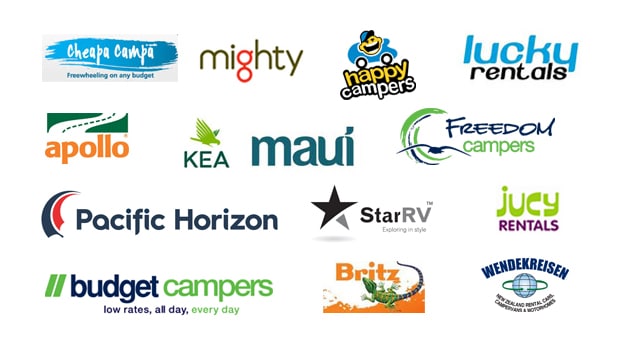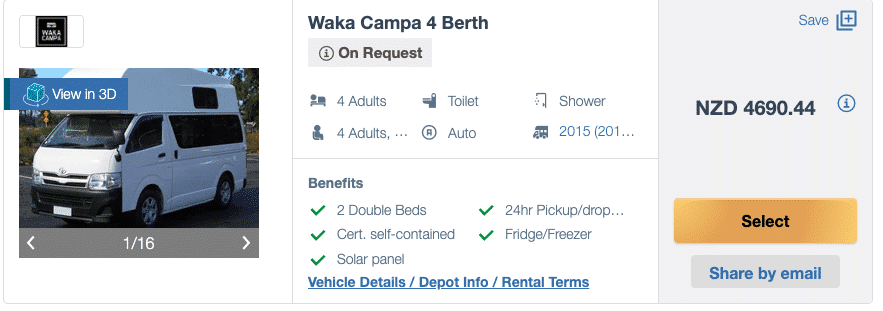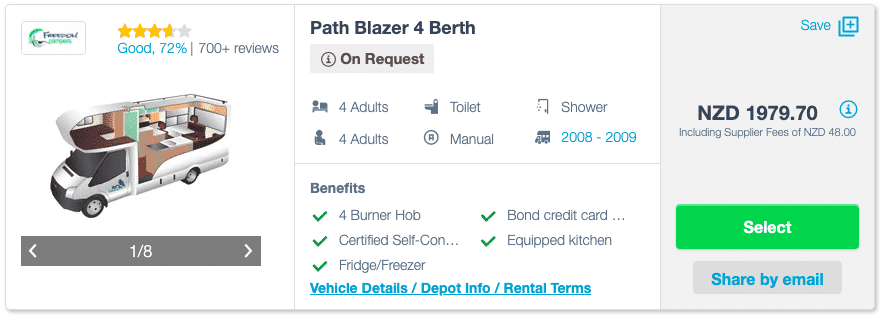Exploring Aotearoa by road is a rite of passage—and hiring your ride in New Zealand opens up both islands’ epic landscapes. While Christchurch offers a convenient hub, this national guide highlights differences, fresh tips and up-to-date rates so you can plan the perfect campervan or motorhome adventure.
Table of Contents
Why Hire Across New Zealand?
Hiring from multiple depots (Auckland, Wellington, Christchurch, Queenstown) lets you avoid hefty one-way fees. North Island roads bring geothermal parks and surf beaches; the South Island delivers alpine passes, fjords and glaciers. A nationwide booking lets you mix city pick-ups with remote drop-offs—perfect for circular itineraries or epic point-to-point journeys.
Motorhome hire comparison
One of the best ways to compare motorhomes in New Zealand is using the website Motorhome Republic. Their search engine compares different models and prices simultaneously to give you the best possible deal, which you can then book directly online (at no additional cost). You also find special offers and sales.
Motorhome Average Daily Rates (NZD) in New Zealand
Renting a motorhome in New Zealand can be quite expensive, especially during school holidays (during Christmas holidays in particular). So if you plan to travel between December and January, you should increase your budget and make your booking as soon as possible!
Motorhome prices vary according to the agency, the availability and season. Booking a motorhome two or three months in advance will be much cheaper than booking one a week before you’re leaving!
👍 Good to know: the daily rates will be lower if you rent a motorhome for a long period of time. Newer and/or better equipped vehicles will obviously be more expensive.
How to Rent a Cheap Motorhome
There are a few things you can do to rent a motorhome on the cheap in New Zealand. As previously mentioned, the first thing you should do is book as soon as possible. Here are a few more tips to get the price down:
- Choose an older model.
- Be flexible on your dates, and if you can, avoid renting during high season (school holidays).
- Book in advance, as prices tend to increase as the rental date approaches and demand increases.
- Pick up your motorhome in one of the two main cities (Auckland or Christchurch).
- Rates are often lower for rentals from Christchurch to Auckland (rather than the other way around).
- Rent for more than 7 or 14 consecutive days to save money on your daily rate. Rates are degressive depending on the rental period.
- Use a price comparison website.
- Look for promo codes or special offers: Special motorhome rental offers.
- Use promo codes (for example 5% off with Travellers Autobarn with code : GUIDEEN)
🚐 Save 5% on campervan rentals with Travellers Autobarn
Rent your van in Australia for cheaper with Travellers Autobarn thanks to our promo code: GUIDEEN
Where to rent a Motorhome in New Zealand?
From Auckland or Christchurch?
When choosing your pickup location, consider both convenience and cost. Auckland Airport hosts the largest concentration of rental depots—Maui, Britz, Apollo and the rest all have shuttles from the terminal—and while daily rates here tend to be 10–15 % higher than in the South Island, you gain instant access to the North Island’s geothermal parks, beaches and the Interislander ferry terminal in nearby Wellington. Dropping your motorhome off in a different city (for example, in Christchurch instead of Auckland) usually incurs a one-way fee of NZD 200–400, so build that into your budget. If you plan to explore only the North Island, looping back to Auckland—or ending in Wellington—can avoid that surcharge and let you return the vehicle to the same depot where you picked it up.
Which Island do you wish to explore?
Some travellers choose to visit only one of the islands (either North or South) and return their vehicle in the same city where they collected it. To visit the North Island, it is also possible to cross the entire North Island from Auckland to Wellington. However, there are fewer rental companies and prices are higher in Wellington.
To visit the South Island, you can do a loop around Christchurch from north to south (or vice versa) or decide to visit only the north or south part of the South Island. Other cities where you can rent a motorhome include Nelson (very few rental companies), Dunedin (again, very few rental companies) and Queenstown (more companies).
Motorhome and campervan rental companies in New Zealand
High end/mid-range companies: Apollo, Kea, Maui, Britz, Wendekreisen, Star RV, Freedom Campers, Jucy, Pacific Horizon.
Low-budget companies: Mighty, Budget Campers, Lucky Rentals, Cheapa Campa, Happy Campers.

Motorhome Models and equipment in New Zealand
As a reminder, we use the term “motorhome” for self-sufficient vehicles, equipped with a shower and toilet. How equipped your vehicle is is important because camping rules are very strict in New Zealand. Some camping sites (free or paid) will only accept self-contained vehicles. If you rent a motorhome as opposed to a campervan, you will have more choice as to where to spend your nights.
2-seater motorhome
2-seater motorhomes often come from the same manufacturer (Ford Transit, Mercedes Sprinter, Volkswagen Crafter), which are all pretty similar. They are equipped with a double bed in the back, which can be converted into a bench with dining table. They have a small fitted kitchenette in the front, with a shower cabin just behind the driver’s seat.
Due to its size, this model is easy to drive and doesn’t need much petrol. It is obviously suitable for singles or couples.
3-seater motorhome
3-seater motorhomes are not very common. As they are not generally much larger than 2-seater motorhomes, they can only accommodate a couple and a child.
4-seater motorhome
The 4-seater motorhome is probably the most popular model. Equipped with 2 double beds, it is ideal for families or couples. If you are a group of friends, you’ll have to share beds, so it will get pretty cosy!
4-seater motorhomes come with a large double bed in the front of the vehicle, which is convertible into a bench with a table. There’s a second double bed above the front seats. The kitchen area, as well as the shower and toilet cabin, are at the rear of the vehicle.
Most of these models are Volkswagen or Mercedes (ranging from 10 to 2 years old).
5-seater motorhome
These models are hard to find. Some companies offer vehicles called “4 + 1” to accommodate 4 adults and a child.
6-seater motorhome
These are the largest models available in New Zealand. With 3 large beds, there is enough space for a family or a group of friends. These are also a good option for 4 people who need a larger living space. In this case, you can leave one of the converted beds set up as a table, so you don’t have to undo the bed every morning.
Motorhome equipments
Motorhomes are usually well equipped. At the very least, you will have a place to cook and sleep. But depending on the brands and models, you might get some extra equipment included. Make sure you read all the details of your motorhome closely when making your booking. Here’s a brief description of the equipment that is either included or optional:
- Beds (double, single or children beds)
- Small kitchen with all of the necessities
- Shower cabin with toilet
- Lounge area with a table and benches
- Storage spaces.
Usually optional:
- DVD player / GPS
- Bedding and towels
- Child seats
- Camping table and chairs.
Motorhome Rental Insurance
Standard insurance is included in the rental price. It covers personal injury inflicted on third parties. It does not cover any material damage of the rental vehicle or other vehicles. For this reason, the rental agent will ask you to pay a deposit when picking up the motorhome. They usually charge the money to your account, so make sure you have the funds available! The amount to be paid depends on the company and type of vehicle. For a campervan, deposits are usually around 3,000 NZD. For a motorhome, expect to be charged between 5,000 and 7,500 NZD.
If you don’t want take any risks, make sure you get comprehensive insurance. Your deposit will then be reduced to a minimum amount (generally around 250 NZD).
But it is also possible to take out private insurance or use the coverage offered by your credit card (check with your bank beforehand). If you want more information on motorhome rental insurance, we recommend that you take a look at our dedicated article: Motorhome insurance options in Australia and NZ.
What to check when picking up the vehicle
When renting a motorhome, it is very important to check the condition of the vehicle and its equipment before you drive off. These are few things to have a look at before hitting the road:
- Make sure that you got the model you booked. If the vehicle you booked is not available, you may be offered an alternative. In this case, you should get an upgrade or a discount.
- Thoroughly inspect the outside of the vehicle and let the rental agent know of even the slightest scratch.
- Take pictures as evidence of the initial condition of the vehicle.
- Ask questions about how everything works (electricity, shower, waste water, battery charging etc.)
- Also be sure to read your contract to be aware of what the insurance will not cover, and any additional costs.
Where to sleep with a motorhome in New Zealand?
Wild camping is prohibited in New Zealand. Legislation is strict on camping pitches in the country, and only “self contained” vehicles can park in free camping areas for the night.
Self-contained vehicles are “self sufficient”. That is to say that the vehicle does not require external resources and must be able to contain its waste for a minimum of 3 days. Self-contained vehicles can be recognised by a blue sticker on the windshield. These are usually motorhomes. So if you rent a motorhome with this little blue sticker, no worries! You can choose to spend your nights on the free areas or go to paid campsites.
To find the parking areas or campsites on your route, you can refer to the guide which is usually provided when you rent a vehicle. Alternatively, you can download the Wikicamp or Campermate apps, which list points of interest, campsites, rest areas, etc.
Best Season to visit New Zealand
🌸🍂 Best season: Spring and Autumn
- Pros: Spring (September to November) and autumn (March to May) offer pleasant temperatures, colourful landscapes and fewer crowds. Motorhome rental rates are generally lower during these low seasons than in summer. You’ll also have better access to campsites and tourist attractions without the summer crowds. These seasons are ideal for exploring both the North Island, with its milder climate, and the South Island, known for its mountainous landscapes and autumn colours.
- Cons: Spring can bring unpredictable rain, and some tourist attractions may have reduced opening times or be closed, especially in autumn. In addition, although the weather is generally mild, it can be variable, with cool days and cold nights, particularly in the South Island.
☀️ Alternative : Summer
- Pros: Summer (December to February) is New Zealand’s peak tourist season. You’ll enjoy long, sunny days, ideal for outdoor activities such as hiking, cycling and exploring the beaches. It’s the perfect time to visit the magnificent beaches of the North Island and the spectacular fjords of the South Island.
- Cons: Motorhome hire rates are higher in summer, and it’s advisable to book well in advance. Tourist sites and campsites can be crowded, which can detract from the tranquil experience many seek in New Zealand.
New Zealand Road Trip Itinerary Ideas
The main cities in New Zealand, Auckland and Wellington, are on the north island. In this part of the country, you can see its many volcanoes and its magnificent coasts. There are also many small islands to visit. The North Island can be visited in between 10 and 21 days.
Visit Auckland and surroundings – 5 days
Day 1: Arrival in Auckland and city tour. The two main must-sees in Auckland are the Sky Tower and Mount Eden. Mount Eden is an old volcano in the centre of the city that has magnificent 360-degree views. If you have time, go to Waiheke Island (30 minutes by ferry from downtown Auckland). The island is known for its pristine beaches and world-class vineyards.
Day 2: Drive to the Bay of Islands (3 hours), stopping for water activities such as snorkelling and fishing. Pihan Beach is a beach with volcanic black sand that stretches for kilometres and is said to be Auckland’s best-known surfing beach. The road into Piha Beach is one lane and very steep.
Day 3: Rotorua is a 3-hour drive from Auckland and known for its hot springs, mud baths, and sulphur. Be careful though, the streets of the city centre smell of sulphur, and the smell will quickly get into your clothes! A few must do’s in the area include a traditional Maori dinner (the hangi) in Te Puia, the Polynesian Spa to relax, and for the thrill-seekers, mountain biking in the Redwoods.
Day 4: Drive to Coromandel (1.5 hours) for a day of relaxing on the beaches and exploring the spectacular rocky landscapes. Cathedral Cove, a 40-minute walk to a beach of pure white sand and turquoise waters is not to be missed.
Day 5: Return to Auckland via the replica hobbit village in Hobbiton (1 hour).
This itinerary can be customised to suit your interests and schedule. For example, you can include a day hike in Tongariro National Park, a park with mountains, lakes and hiking trails, including the famous Mount Tongariro mountain loop. You can also visit Cape Reinga, a very sacred place for Maori. Located north of Auckland, it is a place of passage for souls to heaven. The Pacific Ocean and the Tasman Sea meet here, leaving a magnificent sight to unfold before your eyes. Check the weather conditions before you go.
10 day North Island itinerary
If you are planning a 10-day trip, you can discover the following itinerary (in summary):
- Auckland
- Coromandel Peninsula
- Waitomo
- Hamilton
- Rotorua
- taupo
- Tongariro Crossing
- Wellington.
14-20 day North Island itinerary
If you have between 15 and 20 days, we invite you to follow the following itinerary:
- Auckland
- Paihia / Cape Reinga
- Piha
- Waitomo Caves
- Hamilton / Hobbiton
- Coromandel
- Whakatane
- Rotorua
- Taupo
- Tongariro Crossing
- Gisborne
- Wellington.
The South Island is more wild. It is an ideal place for hiking and discovering the local fauna and flora. The South Island is interesting to visit for its landscapes (mountains, fjords, beaches etc.) It will take at least 2 weeks to see the South Island properly, stopping for 2 days at each point of interest. If you want to spend more time visiting the villages, give yourself 3 weeks.
15 day South Island itinerary
- Christchurch
- Hanmer Springs Hot Springs
- Kaikoura
- Abel Tasman and Kahurangi National Park
- Paparoa and Arthur’s Pass National Park
- Fox and Franz Josef Glacier
- Queenstown
- Milford Sounds and Fiordland National Park
- Dunedin
- Lakes Tekapo and Pukaki.
Driving in New Zealand
The country has well-maintained roads, mostly paved. Here are some tips on how you can drive safely:
- Driving is on the left-hand side of the road
- You need an international driving license to rent a vehicle and drive on New Zealand roads.
- Speed limits are regulated and well marked. On main roads, the speed limit is generally 100 km/h.
- You must wear a seatbelt and children aged 7 and under need a restraint.
- New Zealand has more sheep than people, so watch out for animals on the roads!
- Some roads are unpaved. Check the rental conditions of the vehicle and if you can take these roads while remaining covered by your insurance.
- Roads are quite winding in some areas (on the south island). Drive with caution and plan a longer journey time than indicated on your GPS!
FAQ
Renting a vehicle is indeed the best way to discover the country in complete freedom. If you prefer the comfort of a hotel or if you’re travelling during the cooler months of the year, opt for car rental. For the summer months, you will enjoy living in a motorhome while discovering the islands.
No, it is not necessary to have a specific permit. It is, however, compulsory to have a B license (for more than 2 years).
Remember that in New Zealand we drive on the left! The roads are quite winding in places, so be careful, especially when driving a motorhome. In general, the roads are tarred and very well maintained.
To rent a motorhome in New Zealand, you must generally be at least 21 years old, have held a B license for more than a year, have your international license (or national license and official translation) and have a credit card for the deposit.
Updated 24.04.2025



























